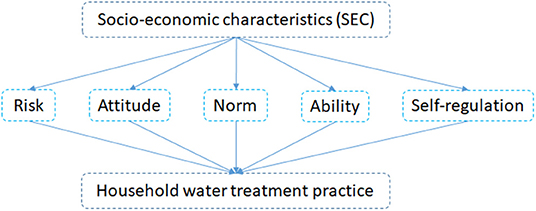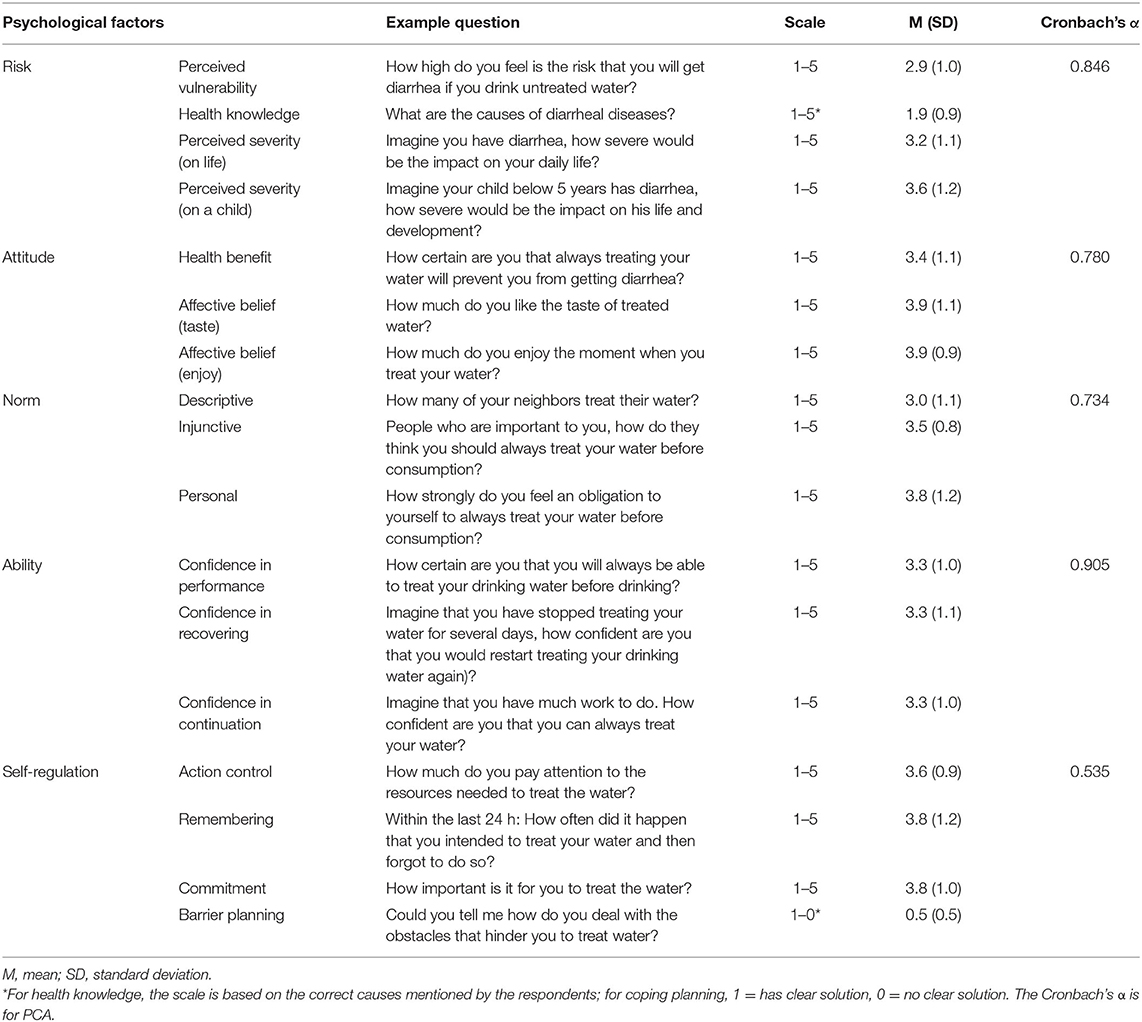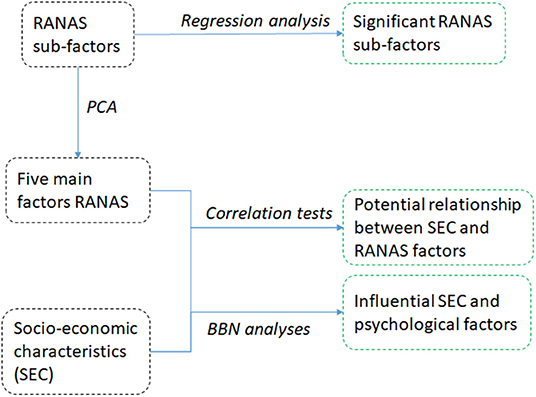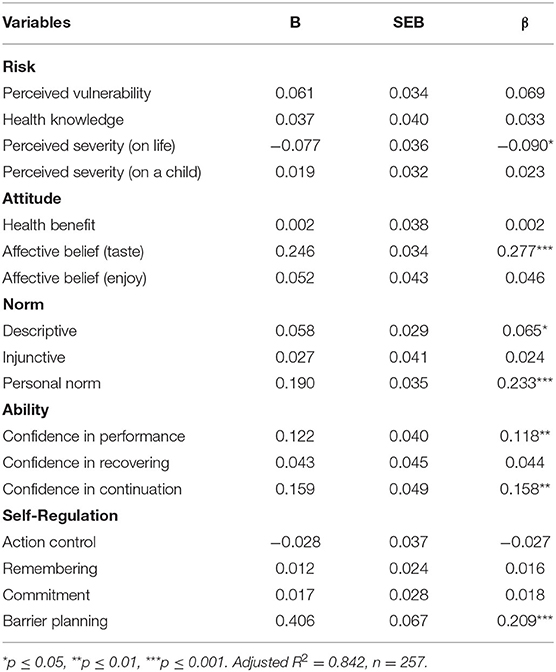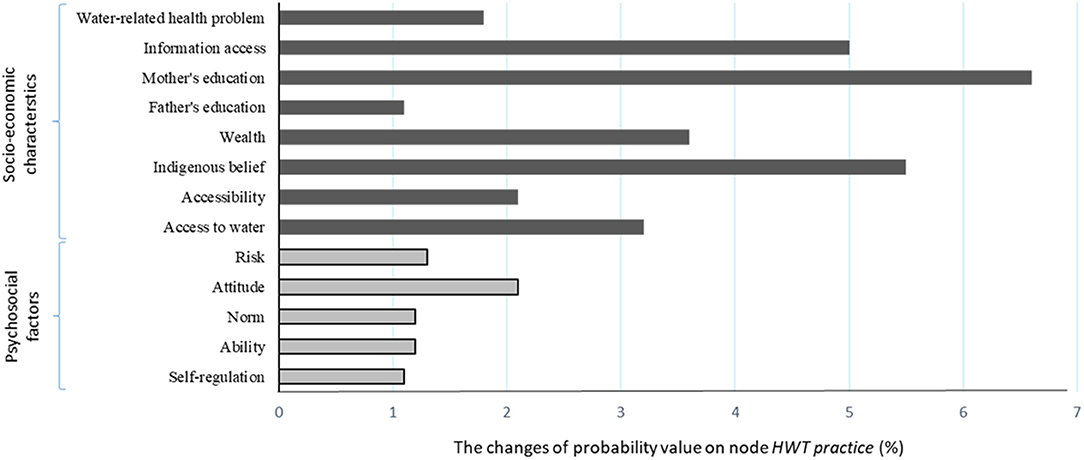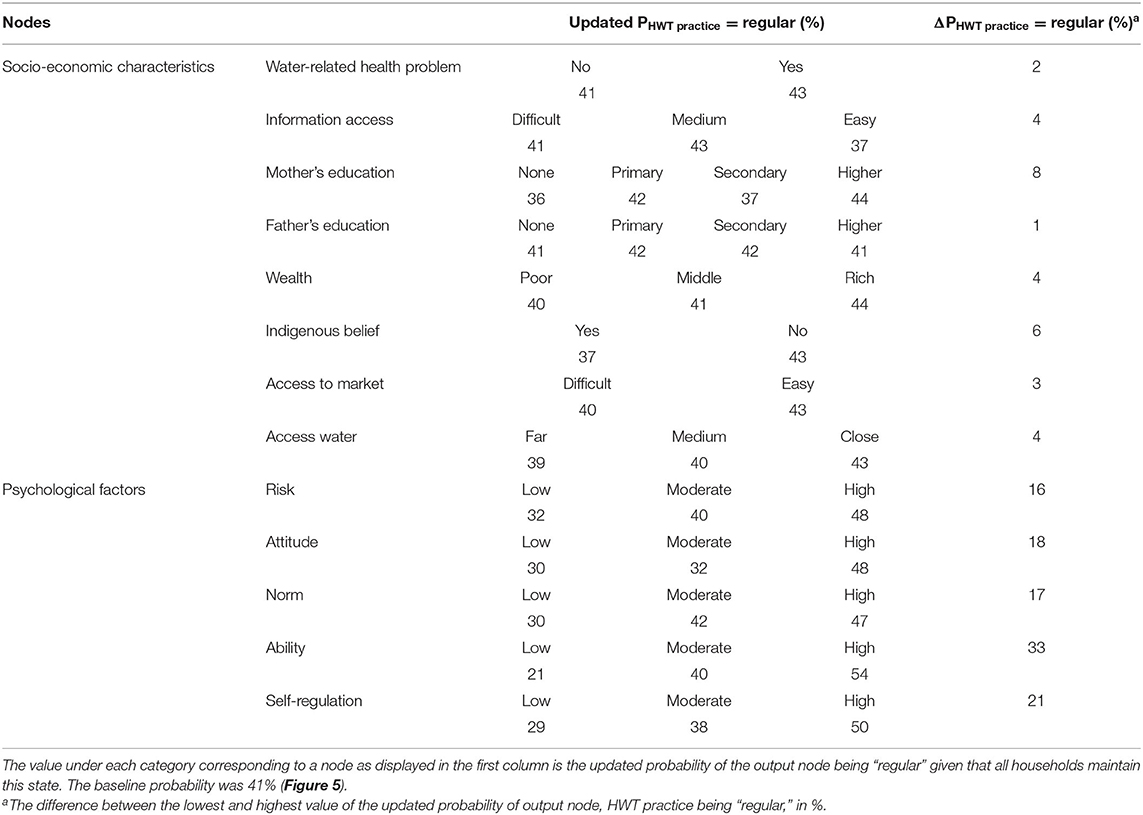- 1Department of Water Management, Faculty of Civil Engineering and Geosciences, Delft University of Technology, Delft, Netherlands
- 2Department of Health Behavior, Environment, and Social Medicine, Faculty of Medicine, Public Health and Nursing, Universitas Gadjah Mada, Yogyakarta, Indonesia
Household water treatment (HWT) is one of the possible technologies to improve the quality of potable water in low–middle-income countries. However, many households still drink untreated water that leads to negative health consequences, highlighting the need for a behavioral study. This study explores the role of eight socio-economic characteristics (SECs) and five psychological factors on the practices of HWT, using a combination of statistical analyses and Bayesian Belief Network (BBN) modeling. The findings were based on 377 household interviews in East Sumba, Indonesia, an area where indigenous belief is still common. Self-reported answers and observed practices of HWT were combined, and 51% of the respondents were categorized as regular users of HWT. Furthermore, favorable socio-economic conditions, e.g., wealthier or more educated parents, facilitated psychological factors that led to regular use of HWT. This suggests the importance of reducing SEC inequalities to improve the HWT adoption. Mother's education was the most influential SEC (ΔP = 8), and people who followed indigenous beliefs tend not to use HWT on a regular basis. Moreover, easy access to water positively influenced the household's ability to operate the HWT technology. Attitude toward the HWT practice, especially the perception of treated water's taste (β = 0.277), was the most significant psychological factor, influencing HWT adoption. An interpretation of complex interlinkages between socio-economic conditions and psychological factors that drive the practice of HWT was therefore offered, alongside recommendations for conservative interventions to change the household's behavior in a culturally unique area with difficult access to water.
Introduction
It was estimated that 2.1 billion people had no access to safely managed drinking water services in 2017 (UNICEF and WHO, 2019). Lack of access to safe drinking water leads to adverse health conditions and inhibits productive activities (Prüss-Ustün et al., 2019). Children below the age of five suffer the most from these water-related diseases, such as diarrhea, stunting, and even mortality (GBD 2016 Diarrhoeal Diseases Collaborators, 2017).
Water, sanitation, and hygiene (WASH) interventions have been conducted intensively in LMICs. Such interventions have included household water treatment (HWT), i.e., treating water oneself within a household, and includes technologies such as boiling, solar disinfection, adding chlorine, or water filtration (Sobsey et al., 2008). HWT has been effective in reducing water-related diseases in LMICs, for example, in studies conducted in Ethiopia (Mengistie et al., 2013) and Bangladesh (Pickering et al., 2019). However, previous studies have found that, in spite of its success, many households in LMICs have not extensively adopted HWT technologies or practiced it regularly (Geremew and Damtew, 2020). This can reduce the positive health effect of HWT (Enger et al., 2013).
Understanding the reasons behind adoption of HWT is essential in order to develop better WASH intervention strategies that sustain appropriate WASH behavior. RANAS, which stands for Risk, Attitude, Norm, Ability, and Self-regulation, is one of the psychological frameworks that has been used to understand the behavioral determinants of diverse water use practices (Mosler, 2012). It has been successful in explaining the use of HWT in developing countries such as Bangladesh (Inauen et al., 2013), Chad (Lilje et al., 2015), and Ethiopia (Sonego et al., 2013).
However, only few HWT studies have included and analyzed behavioral determinants, i.e., SEC and psychological factors (Fiebelkorn et al., 2012), which limits the understanding of such behavior. Dreibelbis et al. (2013) argue that combining the socio-economic characteristics (SECs) and psychological factors can even provide better systems-level understanding of WASH-related behavior. However, Lilje and Mosler (2017) argue that SEC is “less important” to measure because SEC explains only a small portion of the behavior and it is nested within psychological factors. Other WASH studies have similarly suggested that the strength of the influence of SEC is much smaller than psychological factors, once it is combined with psychological factors as independent variables at the same level of regression analysis. See, for e.g., Stocker and Mosler (2015) in the context of cleaning of water storage and Seimetz et al. (2016) in the context of handwashing behavior.
However, Daniel et al. (2020b) tested the hypothesis that the use of HWT is influenced by the household's SEC via psychological factors and the psychological factors are influenced by the household's SEC. The authors used mediation analysis and found statistically significant evidence for the hypothesis that the influence of SEC on HWT adoption is mediated by psychological variables, meaning that SEC and psychological factors could not be analyzed at the same level. A previous study has introduced and implemented this hierarchical causal framework using a Bayesian Belief Network (BBN) and combined SEC and psychological factors to analyze the use of HWT in Nepal (Daniel et al., 2019). RANAS psychological framework guided the analysis. However, RANAS factors have not completely been utilized, potential bias of self-reported answers existed, and limited SECs were used. The study presented in this manuscript therefore tackles the limitations in the previous work (Daniel et al., 2019). In addition, a BBN model with more SEC and a complete set of RANAS psychological factors was developed and constructed. No other study [other than Daniel et al. (2019)] has explored the influence of SEC on psychological factors in HWT or WASH context, i.e., such possible causal relationship has been ignored; see, for e.g., Stocker and Mosler (2015) and Seimetz et al. (2016).
The current study takes up the abovementioned hierarchical causal framework to understand the complex interlinkages between SEC and psychological factors behind the practice of HWT in a rural area in East Sumba, Indonesia. This approach not only is able to understand the complex system behind the practice of HWT but also potentially enables local stakeholders to design relevant interventions considering the household's psychological and SEC to facilitate behavioral change.
Materials and Methods
A cross-sectional study was conducted on August 3–16, 2018, in the district of East Sumba, Province Nusa Tenggara Timur, Indonesia. More than 10% of the total population in the district still follow an indigenous belief, known as “Marapu,” i.e., worship the forefathers (Fowler, 2003; Vel and Makambombu, 2019). Even though only a small portion of the population still officially practice Marapu, there is still a large influence of Marapu on the culture and daily life of the Sumbanese people (Vel and Makambombu, 2010). This area is known to be one of the poorest in Indonesia, where open defecation is common, and the prevalence of malnutrition among children is one of the highest in Indonesia (Picauly and Toy, 2013; Sungkar et al., 2015). The majority of the households used wells (44%) and surface water (spring or river) (32%) as their main drinking water sources (BPS Statistics of East Sumba Regency, 2018). This situation emphasizes the need to practice HWT regularly. However, local NGOs suggested that many of the households in this area still drink untreated water.
We targeted a number of household based on the methodology of Krejcie and Morgan (1970) and Wilson Van Voorhis and Morgan (2007) (see the Supplementary Material for more information). A total of 377 households were randomly visited during transect walk within nine villages and enrollment of every, for example, five houses (Figure 1). There were no exclusion criteria for the participation of households because we aimed to get overall situations in that area. A structured household interview contains the household's socio-demographic information, WASH knowledge and perceptions, and observations by hired local enumerators. The observation covered several hygiene indicators, such as conditions of the toilet and cleanliness of the house. The SECs were encoded in categorical variables, while most of the answers related to psychological factor questions were measured in a five-point Likert scale. The interview targeted a mother as a respondent on behalf of the household, wherever possible, because they are mainly responsible for the water management in the house. The Open Data Kit (ODK) platform on a smartphone was used for the interview and the data were transferred to the computer for analysis. The interviews were conducted in Bahasa Indonesia by six local enumerators. The survey results were checked daily, and if there was a doubt on the data, we confirmed it directly with the enumerator. The Human Research Ethics Committee of Delft University of Technology and the Agency for Promotion, Investment and One-Stop Licensing Service at the province (East Nusa Tenggara) and district (East Sumba) level approved the study setting. Participation was voluntary, and written informed consents were obtained from all respondents; as well as the consent from the village's head prior to the data collection. No household visited declined to participate in the study.
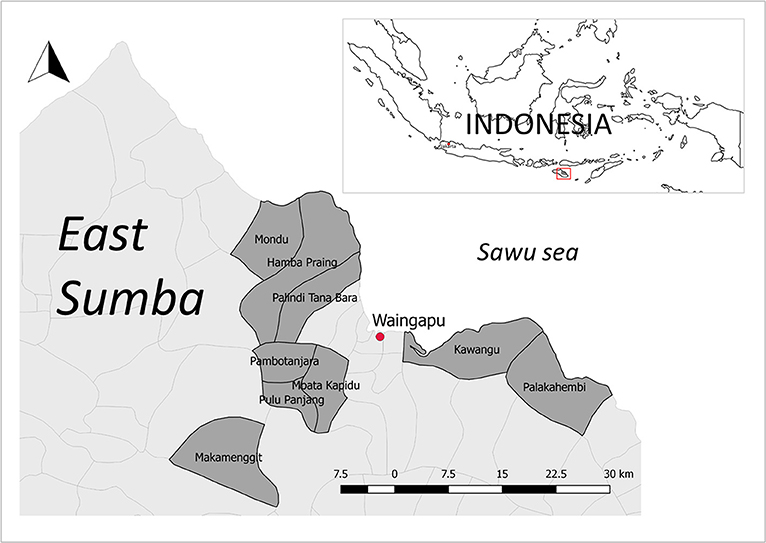
Figure 1. Location of nine villages visited in district East Sumba, Indonesia; drawn using QGIS (QGIS Development Team, 2017).
Bayesian Belief Network
A BBN is a directed acyclic graph showing a hypothetical causal relationship between “causal” variables (called “parent nodes” in BBN) and an “affected” variable (child node) (Pearl, 1988). The strength of a probabilistic relationship between parents and a child node is depicted by the entries in the corresponding Conditional Probability Tables (CPTs). An introduction on BBN can be found in Cain (2001). BBN offers advantages compared to other common statistical methods used to analyze the adoption of water technology or water-related behavior, such as regression analysis. BBN is able to combine expert judgement (qualitative) with actual data to tackle data's uncertainties or unavailability and better visualization of a complex system by multiple stakeholders, while allowing for both predictive and diagnostic inference (Barton et al., 2012).
A BBN structure can be inspired through statistical inference between variables, theory, or by consensus between experts (Nadkarni and Shenoy, 2004). In this study, a three-level hierarchical model depicting how SECs influence the use of HWT via psychological factors was created (Figure 2). BBN has been widely used in water-related studies (Phan et al., 2016, 2019), e.g., for water management and water quality, but has been rarely used in a water-related behavioral study. To the best of our knowledge, only one study has utilized BBN modeling in the behavioral context (Daniel et al., 2019).
Socio-Economic Characteristics
Eight SECs, which were expected to influence the practice of HWT or other WASH behavior based on peer-reviewed literature, were used in this study: (1) Wealth, e.g., mentioned as a significant variable in WASH studies in Sub-Saharan Africa (Munamati et al., 2016) and Indonesia (Roma et al., 2014); (2) Indigenous belief, e.g., in studies in Ethiopia (Behailu et al., 2016) and Australia (Waterworth et al., 2015); (3) Access to market, e.g., in WASH studies in Kenya (Dubois et al., 2010) and Guatemala (Goldman et al., 2001); (4) Water-related health problem, e.g., in HWT studies in rural Bolivia (Christen et al., 2011) and India (Freeman et al., 2012); (5) Information access (George et al., 2016); (6) Mother's education, e.g., in HWT studies in Cameroon (Fotue Totouom et al., 2012) and India (Freeman et al., 2012); (7) Father's education (Dubois et al., 2010); and (8) Access to water (Figueroa and Kincaid, 2010). A respondent's answer to “frequency of watching TV” was used as the proxy for variable Information access. The occurrence of diarrhea in the preceding 2 weeks at the time of visit among children below the age of 5 in the house was used for the variable Water-related health problem. Those studies found, in general, that households that have better socio-economic conditions, e.g., are wealthier, have easier access to market, or have a more educated mother, were more likely to use WASH-related technologies.
RANAS Psychological Factors
RANAS consists of five main factors (Mosler, 2012). Risk is related to the individual's awareness and understanding of HWT-related issues. Attitude represents a person's positive or negative feeling toward HWT. Norm represents the social pressure toward HWT. Ability represents a personal confidence in his or her ability to execute HWT. Finally, Self-regulation reflects personal attempts to self-monitor and plan HWT and deal with conflicting goals. RANAS framework inquires psychological information at the sub-factor level (Mosler, 2012); see also Table 1. Previous WASH studies used RANAS framework to find critical psychological factors that influence the WASH-related behavior, for example, self-regulation (Stocker and Mosler, 2015), ability (Seimetz et al., 2016), and norm (Lilje et al., 2015). By targeting such critical psychological factors, the behavior of a target group can be changed, e.g., toward adoption of technology (Mosler, 2012).
Data Analyses
Two sequential analyses were performed (Figure 3): (1) statistical analysis: regression of the RANAS psychological sub-factors on HWT practice, reduction of RANAS sub-factors to five dominant factors, and correlation tests between each SEC and the five RANAS factors; (2) hierarchical BBN modeling to assess the effect of SEC, via RANAS psycho-social characteristics, on HWT practice. The regression results were used to identify the significant RANAS sub-factors. Furthermore, BBN was performed using SEC and reduced RANAS psychological factors to predict the use of HWT.
Statistical Analyses
Principal Component Analysis (PCA) was performed to create some “latent” variables and reduce dimensionality (i.e., number of variables used in the analysis), before building the BBN model, as conducted also by Daniel et al. (2019). The “latent” variables created as a result were wealth and the five RANAS factors: Risk, Attitude, Norm, Ability, and Self-regulation, and finally HWT practice. Wealth was created from the first principal component of variables linked to the household's assets.
Using all RANAS sub-factors will make a BBN structure too complex and therefore should be avoided (Marcot et al., 2006). Thus, PCA was also used to combine the sub-factor information into one representative variable, i.e., the first principal component, for each RANAS factor. For example, the data of all Norm sub-factors descriptive, injunctive, and personal norm were combined (see Table 1) using PCA and obtained the first principal component as the representative variable (and its corresponding data) Norm. The reliability of performing PCA to represent RANAS main factors and HWT practice have been more extensively discussed in Daniel et al. (2019).
To assess the practice of HWT among the respondents, respondent's answers to four questions related to the use of HWT and observation of the practice by the enumerators at the time of visit, to identify whether the household practiced HWT, were combined. The four questions corresponded to percentage of water treated daily, frequency of drinking raw water daily, habit to perform HWT, and intention to treat water. The intention behind combining multiple answers was to diminish the bias of self-reported behavior, which may overestimate the practice of HWT (Schmidt and Cairncross, 2009). We again used PCA to create a variable HWT practice.
Forced-entry multivariate regression analysis using all RANAS sub-factors was conducted (Table 1) as independent variables with HWT practice as the dependent variable. One-to-one Pearson's correlation tests between each SEC and each of the five factors of RANAS were conducted (each of the five factors being the principal components of the corresponding sub-factors) to identify potential relationships between them. The results were considered when building the final hierarchical BBN structure. All statistical analyses were conducted using IBM SPSS Statistics 24.
BBN Analysis
Discrete BBN requires categorical or discrete information as model inputs. Thus, continuous variables, such as the output of PCA, were discretized into several categories. The respondents were categorized into three groups: (1) for the psychological factors: low (lowest one-third of scores, e.g., low Norm), moderate (one-third to two-thirds of the lowest scores, e.g., moderate Norm), and high (the remaining data); and (2) for the HWT practice: “non-user,” “irregular user”, and “regular user” (using the approach used for psychological factors).
Discretization was also conducted on wealth (after PCA), access to water, and information access for the BBN analysis. For variable wealth in the BBN, three categories were created based on the first principal component's score: poor (the lowest 40%), middle (the next 40%), and rich (the last 20%), as suggested by Houweling et al. (2003). For access to water, respondent's answer “below 5 min” (i.e., 5 min for respondent to walk to the main water source, wait in the line if there is a queue, collect the water, and come back) was coded “close,” “5–30 min” was “medium,” and “above 30 min was “far.” For information access, if the respondent answered “almost never” and “seldom” to indicate the frequency to watch TV daily, then we coded “difficult” information access. If they answered “sometimes” and “quite often,” then information access was coded “medium,” and very often was coded as “easy” information access.
As mentioned previously, a BBN structure can be inspired by statistical relationships, theory, expert knowledge, or hypothetical causal relationship between variables (Nadkarni and Shenoy, 2004). The structure was created by considering statistical relationships, i.e., using the Pearson's correlation tests, and, especially, hypothetical causal relationship between each SEC and psychological factor. For example, even though the Pearson's correlation test showed that there was a significant relationship between “indigenous belief” and “ability,” we did not link them in the BBN structure. That is because we argue that there cannot be a (direct) causal relationship between “indigenous belief” and “ability.” Cain (2001) argues that BBN is composed by “a set of links representing causal relationships between these nodes,” suggesting the hypothetical causal relationship between interconnected nodes in the BBN structure. Therefore, by not linking all significant relationships, we tried to limit the number of parent nodes on each psychological factor.
BBN was performed using Genie 2.2 (http://www.bayesfusion.com). The software uses the Expectation Maximization (EM) algorithm to estimate the entries of CPT, which maps the conditional probability between a child node and all its parent nodes (Druzdzel and Sowinski, 1995; Do and Batzoglou, 2008). The EM algorithm used the inputted data, i.e., the questionnaire results after the discretization steps as explained previously. Ten-fold cross-validation was conducted to assess the model's performance. The sample, i.e., households, is divided into 10 sub-samples and use nine sub-samples for parameter learning and the remaining one for prediction. The model's performance is indicated by the Area Under the Curve (AUC) value of the Receiver Operating Characteristics (ROC) curve in which a value close to one indicates perfect prediction of the output variable (higher sensitivity and lower false positives) (Greiner et al., 2000). Furthermore, sensitivity analysis was conducted to find the most influential variable for the output node. Predictive (forward) and diagnostic (backward) inference were also conducted using the same software.
During the sensitivity analysis, the effect of a small change in the CPT, i.e., model's parameters, of each node on the output node was calculated. The predictive (Bayesian) inference was intended to simulate the influence of specific SEC and psychological nodes, i.e., model's input, on the HWT practice. For example, by updating the node Indigenous belief to 100% “yes,” the value in the psychological node connected to it should change and will thereafter change the value in output node HWT practice. In addition, diagnostic inference was performed, which is the opposite of predictive inference. In diagnostic inference, a desired distribution of states in the output node was set and infer the distribution of states in its parent nodes that could lead to the desired outcome (Zabinski et al., 2018). For example, diagnostic inference of HWT practice at 100% “regular” will identify distribution of states in all SEC and psychological nodes that will lead to such output; i.e., it will identify most probable causes of 100% of households to practice HWT.
Results
Most of the respondents (84%) were the mother, and the rest were the household head. In terms of schooling, 33% of the respondents attended at least secondary school, while only 29% among the household's head (male). The majority of the respondents (87%) had non-permanent housing walls, i.e., wood or bamboo; 7.4% a non-permanent roof, i.e., straw; and 69% a non-permanent floor, i.e., compacted soil. Twenty-six percent of the respondents followed the indigenous belief “Marapu.” Around half of the respondents mentioned that they almost never watched TV (56%). Fifty-two percent of respondents were categorized as living in relatively difficult market access.
Additionally, 29% of the respondents said that they still practiced open defecation, while 50% of the respondents had their own toilet. Thirty-four percent of the respondents had access to a piped water scheme, while 58% still relied on river or well, and 8% bought water from commercial entities or private persons, e.g., water truck or refill water station. Fifty-one percent of the respondents had a water source nearby or in the house, i.e., below 5 min per trip to get water, while 29% of the respondents needed at least 15 min per trip to fetch water. A total of 101 respondents (27%) claimed that almost all of their drinking water was treated, i.e., self-reported answer. However, after using PCA to create the variable HWT practice, 51% of the respondents were categorized as “regularly” practicing HWT, 26% as irregular user, and 23% as non-users. Moreover, 85% of the respondents answered boiling as the HWT method that they often practiced. Very few households used another type of HWT, e.g., commercial water filter (five households), which is because there was no promotion of other types of HWT in that area. Diarrhea incidence among children below the age of 5 was relatively high, 32% in the preceding 2 weeks at the time of visit; i.e., the data collection was conducted in the dry period. A table of descriptive statistics of the respondents can be found in the Supplementary Material.
Statistical Analyses
Table 2 shows the results of the regression analysis using all RANAS sub-factors as predictors of the use of HWT. The results show that perceived severity—on life (risk), affective belief —taste (attitude), descriptive and personal norm, confidence in performance, and in continuation (ability), and barrier planning (self-regulation) were significantly influencing the HWT practice (p ≤ 0.05 in Table 2). Affective belief —taste (attitude) was the most influential psychological sub-factor (the highest β-value in Table 2); i.e., households were more likely to practice HWT regularly if they like the taste of treated water. These 17 psychological RANAS sub-factors explained 84.2% variance in the output variable HWT practice.
Furthermore, Pearson's correlation analyses between each SEC and the five RANAS main factors show that Indigenous belief, access to market, information access, father's education, and wealth were correlated with all RANAS factors (Figure 4). Almost all SECs had positive correlations with the RANAS factors; e.g., the level of risk perception in a house is high if there is a child who frequently gets diarrhea, or the higher the education level of mother and father, the higher is the perception level of the RANAS factors. Exceptions were Indigenous belief and access to water, which had negative correlations with psychological variables. Households who followed indigenous belief and took longer to get water were inclined to have lower levels of psychological factors, e.g., have lower level of ability perception.
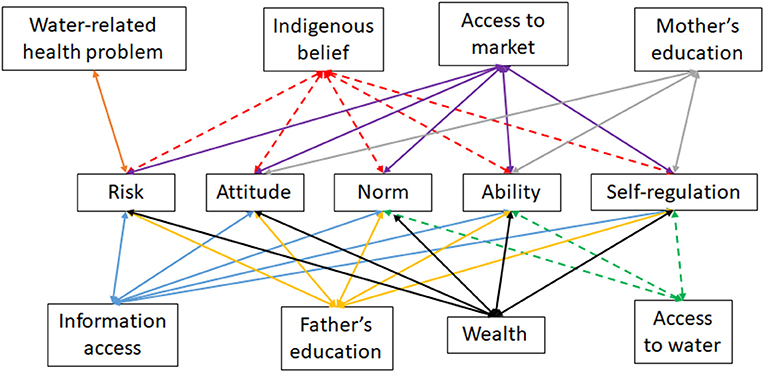
Figure 4. Correlation relationship between SEC and RANAS psychological factors. Solid lines indicate positive correlation and dashed lines indicate negative correlation (Pearson correlation, p ≤ 0.05).
BBN Analyses
Figure 5 shows the complete BBN model, including the “status-quo” (baseline) condition, where 42% of the respondents were categorized as regularly practicing HWT. The average model accuracy to predict the HWT practice was 79%. Furthermore, the accuracy to predict the three categories, non-user, irregular user, and regular user was 79, 54, and 90%, respectively. The area under the ROC curve (AUC) was 0.94, which is categorized as “highly accurate” (Greiner et al., 2000); i.e., the model can distinguish between the three categories in node HWT practice based on the SEC and RANAS psychological data well.
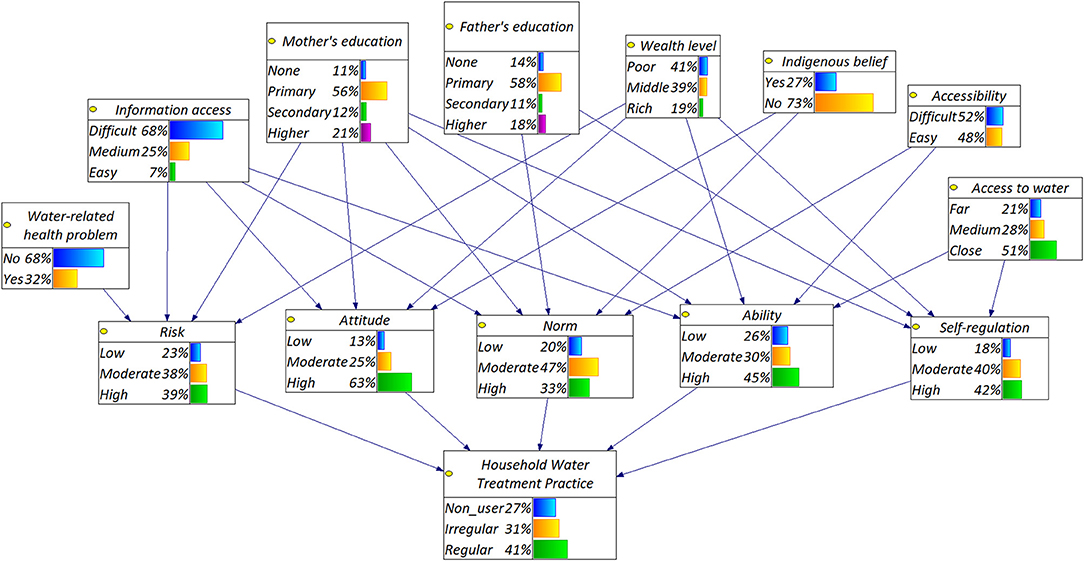
Figure 5. The BBN model showing the hypothetical causal relationship between socio-economic characteristics (SECs), RANAS psychological factors, and HWT practice in rural Indonesia. The bars in each node show the probability that a node is in a certain state (status quo or existing condition).
The sensitivity analysis shows that mother's education, indigenous belief, and information access were the three most influential nodes (Figure 6). Moreover, attitude followed by risk were the most influential psychological variables.
The effect of updating individual nodes on HWT practice, i.e., predictive inference, is shown in Table 3. Overall, the better the socio-economic conditions of households, the more favorable were the psychological factors, i.e., the “level” of psychological factors that facilitate the desired behavior, and then led to higher probability of regularly practicing HWT. The predictive inference found ability as the most important node. If a respondent perceived his/her ability to practice HWT to be low, his/her probability of practicing HWT regularly was only 22%. However, if households were confident, then the probability of treating water regularly jumped to 53%.
Diagnostic inference shows that a higher probability of regularly practicing HWT required higher levels of all five psychological factors. For example, Figure 7 shows that if the level of regularly practicing HWT was set to 100%, then the values in the psychological nodes changed by 4% to 14%. However, the values in all socio-economic nodes did not change much compared to the status quo as shown in Figure 5. Diagnostic inference also shows that attitude was a key psychological factor to change non-user to an irregular user, while ability was a key factor to change irregular to a regular user of HWT—re-affirming the conclusion based on predictive inference.
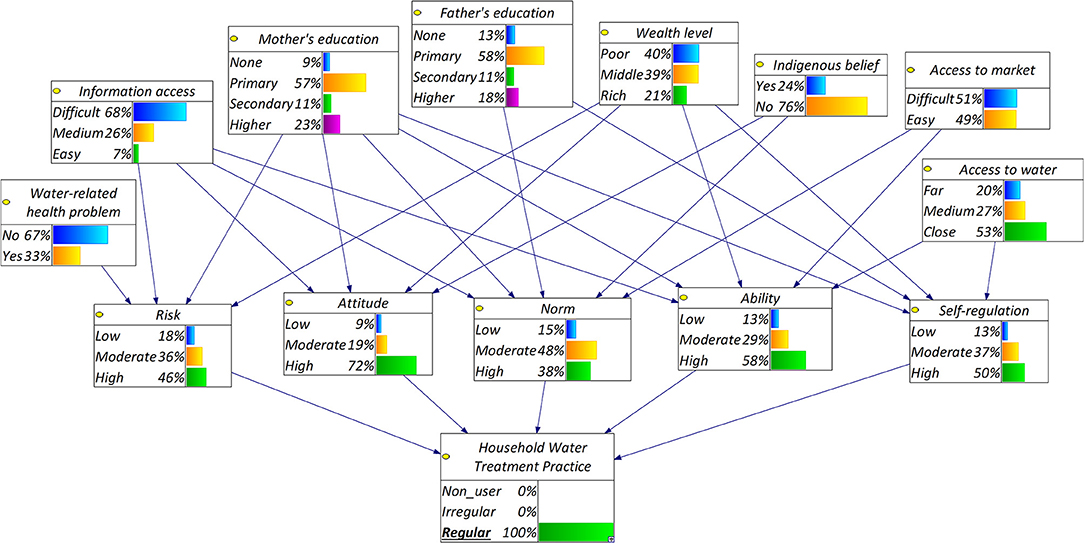
Figure 7. Diagnostic inference: most probable states of all SEC and psychological factors that will lead to the probability of regularly practice HWT to 100%.
Furthermore, the effect of specific SECs on psychological factors connected to it was studied in more detail using the BBN's predictive inference. Households that followed indigenous belief had a lower probability of psychological nodes connected to it being “high,” e.g., attitude and norm (46 and 31%, respectively), compared to households that did not follow the belief (69 and 34% respectively). Another example is that if someone needed to walk more than half an hour to fetch water, then the probability of ability and self-regulation being “high” was only 42 and 36%, respectively, compared to 47 and 46%, if they needed to walk <5 min. The effect of other SEC on psychological factors were in a “positive direction”: higher parent's education level, easier information access, wealthier, having water-related health problem, and more accessible location all had a positive influence on the psychological factors and then on the HWT practice.
Discussion
Explaining water-related behavior, such as the practice of HWT, is very complex, particularly because there are multiple factors involved (Peters, 2014). Using a system-based approach that combines SECs and psychological factors, this study found that locally rooted belief and access to water highly influence people's perceptions (psychological factors) and thus the adoption of HWT. Moreover, using complete RANAS variables in the analyses, including more relevant SECs, and minimizing the bias from respondent's self-reported answers, the model's performance of this study was better than the one in Daniel et al. (2019), as shown by the AUC value of 0.94, and also provided better interpretations of within-system interactions resulting in more confident recommendations.
The results of the sensitivity analysis and predictive (Bayesian) inference show the same pattern. For example, a more educated mother perceived a higher level of the psychological factors, i.e., a positive correlation (Figure 4). This is in line with the findings of Figueroa and Kincaid (2010) who mentioned that a more educated mother may have a better understanding of the health risk of untreated water and could manage and plan better about the practice of HWT. In addition, since the mother is the primary adult caretaker and usually responsible for home WASH management, the new ways of thinking obtained from the promotional activities or school are probably translated into a sustained behavior and followed by other household members (Allen et al., 2018).
The effect of other individual socio-economic and psychological characteristics are also consistent with the literature. For example, easier information access may facilitate the spread of knowledge and understanding of health risks from untreated drinking water (George et al., 2016; Daniel et al., 2019). Easier access to market also stimulates more confidence in getting the resources needed to adopt HWT while wealth represents their ability to purchase the resources (Opryszko et al., 2010; Roma et al., 2014). This suggests that “context matters” and that SECs of households play an important role in context of health-related behavior (Manstead, 2018), e.g., in the case of women's sanitation use in Africa (Winter et al., 2018). This paper argues that including SECs is essential in order to implement a system thinking approach (Dreibelbis et al., 2013) to interpret the behavior or investigate “the causes of the causes” (Braveman and Gottlieb, 2002). Since the results show that better SECs lead to regular practice of HWT, reducing disparities in SECs is essential for healthier behavior (Adler and Newman, 2002). The similar interpretation may apply to the context of technology adoption among people in developing countries.
Indigenous belief played a significant role in this study. The analysis found it to be negatively correlated with both psychological factors of households and the HWT behavior. However, how indigenous belief “Marapu” influences the psychological factors of the people is not well-understood and should be investigated in future studies. Some WASH-related behavioral studies have also highlighted that indigenous belief plays a critical role. For example, rainwater is considered to be blessed by God and therefore HWT is perceived not to be needed in some areas of Kenya (Harris, 2005). Water from rivers such as River Ganga is considered pure by religious people in India for the same reason and often consumed without treatment (Kley and Reijerkerk, 2009). Being a Christian or not has been found to be a significant predictor of using private latrine (Winter et al., 2018). In addition, indigenous belief has facilitated a high sanitation coverage in Uganda (Okurut et al., 2015) but has led to distrust in filtered water in Bangladesh (Johnston et al., 2010). Other studies have also mentioned indigenous belief as important drivers of HWT practice in Pakistan (Mahmood et al., 2011) and Nepal (Rainey and Harding, 2005).
By understanding more about the role of belief, behavioral change interventions could be better designed, without changing their unique cultural belief and practices. For example, religious leaders could be involved in the WASH promotion activities (Dwipayanti et al., 2019). This might also work in East Sumba since the religious leader is highly influential there.
Households who need more time to collect water perceived lower levels of ability and self-regulation to operate HWT technologies. That is probably because the time to treat water, e.g., to boil and cool water (Clasen T. et al., 2008), competes with the time needed to fetch water. This issue is particularly important in East Sumba where the area faces serious drought throughout the year (Messakh et al., 2018). This finding underlines the need for easier access to the water supply to facilitate a behavioral change toward the adoption of HWT, especially because ability and self-regulation are the main two factors that related to the continuation of the behavior (Mosler, 2012).
From the BBN sensitivity analysis, the psychological factor attitude of households toward HWT was found to be the most influential variable (Figure 6). In addition, psychological sub-factor affective belief (taste), i.e., one of attitude sub-factors, was the most influential variable in the regression analysis. This suggests that if households in the area like the taste (or temperature) of the treated water, they are highly likely to regularly practice HWT. This finding could be related to another study in Pakistan where households preferred to have fresh and cold water in hot weather (Luby et al., 2001). A similar interpretation may apply to Sumba since this island is a quite hot and humid area; i.e., people prefer to have raw fresh water taken directly from tap, river, or well. Moreover, since the perception of risk appears as the second important psychological factor in BBN, highlighting the poor water quality of the fresh—but untreated—water is one of the important focuses to change the behavior. However, extra effort would be needed to ensure that households perceive treated water more positively, e.g., by finding opportunities where households experience the taste (freshness) of treated water. Boiling, which is common in the Sumba area, will release the dissolved oxygen in the water and make the water taste less fresh and thus may not be the preferred option. Therefore, other treatment systems, such as SODIS, could be a preferred option since it does not change the taste of water (Luzi et al., 2016).
There are some limitations to the presented study. First, 16% of the respondents were not the mother, i.e., the one responsible for the water management in the house. However, the means of five psychological factors and HWT practice were not significantly different (p > 0.05). Second, we only assessed the HWT practice in this study and not the safe storage practice. Safe storage is needed to prevent recontamination of treated water (Mintz et al., 1995), and, indeed, in another study in the same area, it was found that there is a “moderate” chance of recontamination due to inappropriate water storage (Daniel et al., 2020a). This implies that even though households were categorized as regularly practicing HWT in this study, the drinking water quality may not be safe to drink. Therefore, we recommend that promotion of HWT in that area must be accompanied by promotion of safe storage and hygienic conditions in the household. Future HWT studies in that area have also to include the assessment of safe storage practice in addition to the HWT practice. Third, we did not measure and include the organoleptic aspects of the water (smell, color, taste, and turbidity) in the analysis. These aspects were found to influence the perception of water quality (Doria et al., 2009) and thus should be analyzed further in the study area. Fourth, to the best of our knowledge, there is no practical method to confirm the actual practice of boiling, such as measuring the residual chlorine or observing the presence of bottles in the case of chlorination and solar disinfection, respectively. Therefore, a potential of self-reported bias in our study exists, even though we tried to minimize it by combining multiple answers. A previous study in Cambodia found that only one-third of the self-reported households had boiled water at follow-up visits (Brown and Sobsey, 2012). In addition, other studies found that boiling does not fully eliminate the water contamination (Clasen T. et al., 2008; Clasen T. F. et al., 2008). A future study should also analyze the effectiveness of boiling practice in this area.
Conclusion
In this study, the role of SECs of people in the indigenous Sumba area in Indonesia on the water-related perceptions and the practice of HWT were analyzed. Statistical analyses were combined with BBN models to accomplish this. It was found that SECs influenced water-related perceptions (psychological factors), resulting in higher or lower adoption of HWT. Indigenous beliefs played a significant role in influencing household perceptions, suggesting the importance of considering local culture in the dissemination of health- or environmental-related advisories and adoption of relevant technologies in developing countries. Access to water was found to be important for households to develop the ability to practice HWT. For improved adoption of HWT, attitude toward the HWT, especially the taste of treated water, also needs to be addressed to influence households to practice HWT. Finally, this paper argues that improving the aforementioned SECs of the respondents is essential to ensure the sustainable use of HWT or any environmental-related technologies in developing countries.
Data Availability Statement
The original contributions presented in the study are included in the article/Supplementary Materials, further inquiries can be directed to the corresponding author/s.
Ethics Statement
The studies involving human participants were reviewed and approved by the Human Research Ethics Committee of Delft University of Technology and the Agency for Promotion, Investment, and One-Stop Licensing Service at the province (East Nusa Tenggara) and district (East Sumba) level. The patients/participants provided their written informed consent to participate in this study.
Author Contributions
DD: term, methodology, software, formal analysis, investigation, resources, writing—original draft, writing—review & editing, visualization, and funding acquisition. SP: term, conceptualization, methodology, validation, writing—review & editing, supervision, and project administration. LR: term, conceptualization, validation, writing—review & editing, supervision, project administration, and funding acquisition. All authors have read and agreed to the published version of the manuscript.
Funding
DD receives a Ph.D., research funding from Indonesia Endowment Fund for Education (LPDP). Delft University of Technology provided funds to support field logistics and research activities.
Conflict of Interest
The authors declare that the research was conducted in the absence of any commercial or financial relationships that could be construed as a potential conflict of interest.
Acknowledgments
We thank the respondents for their participation in the study; all enumerators: Antonia Djarawula, Primus Lede, Selia Nangi, Jems Ndapangadung, Dominggus Wulang, and Yemima Amah; and Yayasan Anugerah Anak Sumba for assistance during the data collection.
Supplementary Material
The Supplementary Material for this article can be found online at: https://www.frontiersin.org/articles/10.3389/frwa.2021.649445/full#supplementary-material
References
Adler, N. E., and Newman, K. (2002). Socioeconomic disparities in health: pathways and policies inequality. Health Aff. 2, 60–76. doi: 10.1377/hlthaff.21.2.60
Allen, E., Morazan, I. M., and Witt, E. (2018). Actively engaging women is helping solve the global water crisis. J. Water Sanit. Hyg. Dev. 8, 632–639. doi: 10.2166/washdev.2018.025
Barton, D. N., Kuikka, S., Varis, O., Uusitalo, L., Henriksen, H. J., Borsuk, M., et al. (2012). Bayesian networks in environmental and resource management. Integr. Environ. Assess. Manag. 8, 418–429. doi: 10.1002/ieam.1327
Behailu, B. M., Pietilä, P. E., and Katko, T. S. (2016). Indigenous practices of water management for sustainable services. SAGE Open 6, 1–11. doi: 10.1177/2158244016682292
BPS Statistics of East Sumba Regency (2018). Persentase rumah tangga menurut sumber air utama yang digunakan untuk minum di kabupaten sumba timur, 2015-2017. Stat. Sumba Timur Regency. Available online : https://sumbatimurkab.bps.go.id/dynamictable/2018/11/12/50/persentase-rumah-tangga-menurut-sumber-air-utama-yang-digunakan-untuk-minum-di-kabupaten-sumba-timur-2015-2017.html (accessed April 1, 2020).
Braveman, P., and Gottlieb, L. (2002). The social determinants of health : it ' s time to consider the causes of the causes. Public Health Rep. 129, 19–31. doi: 10.1177/00333549141291S206
Brown, J., and Sobsey, M. D. (2012). Boiling as household water treatment in Cambodia: a longitudinal study of boiling practice and microbiological effectiveness. Am. J. Trop. Med. Hyg. 87, 394–398. doi: 10.4269/ajtmh.2012.11-0715
Cain, J. (2001). Planning Improvements in Natural Resources Management. Oxfordshire: UK Centre for Ecology & Hydrology.
Christen, A., Duran Pacheco, G., Hattendorf, J., Arnold, B. F., Cevallos, M., Indergand, S., et al. (2011). Factors associated with compliance among users of solar water disinfection in rural Bolivia. BMC Public Health 11, 210. doi: 10.1186/1471-2458-11-210
Clasen, T., Mclaughlin, C., Nayaar, N., Boisson, S., Gupta, R., Desai, D., et al. (2008). Microbiological effectiveness and cost of disinfecting water by boiling in semi-urban India. Am. J. Trop. Med. Hyg. 79, 407–413. doi: 10.4269/ajtmh.2008.79.407
Clasen, T. F., Thao, D. H., Boisson, S., and Shipin, O. (2008). Microbiological effectiveness and cost of boiling to disinfect drinking water in rural Vietnam. Environ. Sci. Technol. 42, 4255–4260. doi: 10.1021/es7024802
Daniel, D., Diener, A., Pande, S., Jansen, S., Marks, S., Meierhofer, R., et al. (2019). Understanding the effect of socio-economic characteristics and psychosocial factors on household water treatment practices in rural Nepal using Bayesian belief networks. Int. J. Hyg. Environ. Health 222, 847–855. doi: 10.1016/j.ijheh.2019.04.005
Daniel, D., Iswarani, W. P., Pande, S., and Rietveld, L. (2020a). A bayesian belief network model to link sanitary inspection data to drinking water quality in a medium resource setting in rural Indonesia. Sci. Rep. 10:18867. doi: 10.1038/s41598-020-75827-7
Daniel, D., Pande, S., and Rietveld, L. (2020b). The effect of socio-economic characteristics on the use of household water treatment via psychosocial factors: a mediation analysis. Hydrol. Sci. J. 65, 2350–2358. doi: 10.1080/02626667.2020.1807553
Do, C. B., and Batzoglou, S. (2008). What is the expectation maximization algorithm? Nat. Biotechnol. 26, 897–899. doi: 10.1038/nbt1406
Doria, M. F., Pidgeon, N., and Hunter, P. R. (2009). Perceptions of drinking water quality and risk and its effect on behaviour : a cross-national study. Sci. Total Environ. 407, 5455–5464. doi: 10.1016/j.scitotenv.2009.06.031
Dreibelbis, R., Winch, P. J., Leontsini, E., Hulland, K. R., Ram, P. K., Unicomb, L., et al. (2013). The integrated behavioural model for water, sanitation, and hygiene: a systematic review of behavioural models and a framework for designing and evaluating behaviour change interventions in infrastructure-restricted settings. BMC Public Health 13:1015. doi: 10.1186/1471-2458-13-1015
Druzdzel, M. J., and Sowinski, T. (1995). GeNIe Modeler. Available online at: https://www.bayesfusion.com/
Dubois, A. E., Crump, J. A., Keswick, B. H., Slutsker, L., Quick, R. E., Vulule, J. M., et al. (2010). Determinants of use of household-level water chlorination products in rural Kenya, 2003-2005. Int J. Env. Res. Public Health 7, 3842–3852. doi: 10.3390/ijerph7103842
Dwipayanti, N. M. U., Rutherford, S., and Chu, C. (2019). Cultural determinants of sanitation uptake and sustainability: local values and traditional roles in rural Bali, Indonesia. J. Water Sanit. Hyg. Dev. 9, 438–449. doi: 10.2166/washdev.2019.178
Enger, K. S., Nelson, K. L., Rose, J. B., and Eisenberg, J. N. S. (2013). The joint effects of efficacy and compliance: a study of household water treatment effectiveness against childhood diarrhea. Water Res. 47, 1181–1190. doi: 10.1016/j.watres.2012.11.034
Fiebelkorn, A. P., Person, B., Quick, R. E., Vindigni, S. M., Jhung, M., Bowen, A., et al. (2012). Systematic review of behavior change research on point-of-use water treatment interventions in countries categorized as low- to medium-development on the human development index. Soc Sci Med. 75, 622–633. doi: 10.1016/j.socscimed.2012.02.011
Figueroa, M., and Kincaid, D. (2010). Social, Cultural and Behavioral Correlates of Household Water Treatment and Storage. Center of Communication Programs. Available online at: http://ccp.jhu.edu/wp-content/uploads/Household-Water-Treatment-and-Storage-2010.pdf
Fotue Totouom, A. L., Sikod, F., and Abba, I. (2012). Household choice of purifying drinking water in cameroon. Environ. Manag. Sustain. Dev. 1, 101–115. doi: 10.5296/emsd.v1i2.1642
Fowler, C. T. (2003). The ecological implications of ancestral religion and reciprocal exchange in a sacred forest in Karendi (Sumba, Indonesia). Worldviews Environ. Cult. Relig. 7, 303–329. doi: 10.1163/156853503322709155
Freeman, M. C., Trinies, V., Boisson, S., Mak, G., and Clasen, T. (2012). Promoting household water treatment through women's self help groups in rural india: assessing impact on drinking water quality and equity. PLoS ONE 7:e44068. doi: 10.1371/journal.pone.0044068
GBD 2016 Diarrhoeal Diseases Collaborators (2017). Estimates of global, regional, and national morbidity, mortality, and aetiologies of diarrhoeal diseases: a systematic analysis for the global burden of disease study 2015. Lancet. Infect. Dis. 17, 909–948. doi: 10.1016/S1473-3099(17)30276-1
George, C. M., Jung, D. S., Saif-Ur-Rahman, K. M., Monira, S., Sack, D. A., Rashid, M. U., et al. (2016). Sustained uptake of a hospital-based handwashing with soap and water treatment intervention (cholera-hospital-based intervention for 7 days [CHoBI7]): a randomized controlled trial. Am. J. Trop. Med. Hyg. 94, 428–436. doi: 10.4269/ajtmh.15-0502
Geremew, A., and Damtew, Y. T. (2020). Household water treatment using adequate methods in sub-saharan countries: evidence from 2013–2016 demographic and health surveys. J. Water Sanit. Hyg. Dev. 10, 66–75. doi: 10.2166/washdev.2019.107
Goldman, N., Pebley, A. R., and Beckett, M. (2001). Diffusion of ideas about personal hygiene and contamination in poor countries: evidence from Guatemala. Soc. Sic. Med. 52, 53–69. doi: 10.1016/S0277-9536(00)00122-2
Greiner, M., Pfeiffer, D., and Smith, R. D. (2000). Principles and practical application of the receiver-operating characteristic analysis for diagnostic tests. Prev. Vet. Med. 45, 23–41. doi: 10.1016/S0167-5877(00)00115-X
Harris, J. (2005). Challenges to the Commercial Viability of Point-of-Use (POU) Water Treatment Systems in Low-Income Settings. Master's thesis. Oxford: Oxford School of Geography and the Environment Oxford University.
Houweling, T. A. J., Kunst, A. E., and Mackenbach, J. P. (2003). Measuring health inequality among children in developing countries: does the choice of the indicator of economic status matter? Int. J. Equity Health 2, 1–12. doi: 10.1186/1475-9276-2-8
Inauen, J., Hossain, M. M., Johnston, R. B., and Mosler, H. J. (2013). Acceptance and use of eight arsenic-safe drinking water options in Bangladesh. PLoS ONE 8:e53640. doi: 10.1371/journal.pone.0053640
Johnston, R. B., Hanchett, S., and Khan, M. H. (2010). The socio-economics of arsenic removal. Nat. Geosci. 3, 2–3. doi: 10.1038/ngeo735
Kley, L. S., and Reijerkerk, L. (2009). Water a Way of Life. Leiden: CRC Press/Balkema. doi: 10.1201/9780203872369
Krejcie, R. V., and Morgan, D. W. (1970). Determining sample size for research activities. Educ. Psychol. Meas. 30, 607–610. doi: 10.1177/001316447003000308
Lilje, J., Kessely, H., and Mosler, H. J. (2015). Factors determining water treatment behavior for the prevention of cholera in Chad. Am. J. Trop. Med. Hyg. 93, 57–65. doi: 10.4269/ajtmh.14-0613
Lilje, J., and Mosler, H.-J. (2017). Socio-psychological determinants for safe drinking water consumption behaviors: a multi-country review. J. Water Sanit. Hyg. Dev. 7, 13–24. doi: 10.2166/washdev.2017.080
Luby, S., Agboatwalla, M., Raza, A., Sobel, J., Mintz, E., Baier, K., et al. (2001). A low-cost intervention for cleaner drinking water in Karachi, Pakistan. Int. J. Infect. Dis. 5, 144–150. doi: 10.1016/S1201-9712(01)90089-X
Luzi, S., Tobler, M., Suter, F., and Meierhofer, R. (2016). SODIS manual Guidance on Solar Water Disinfection. Du: Eawag, Swiss Federal Institute of Aquatic Science and Technology. Available online at: www.sodis.ch
Mahmood, Q., Baig, S. A., Nawab, B., Shafqat, M. N., Pervez, A., and Zeb, B. S. (2011). Development of low cost household drinking water treatment system for the earthquake affected communities in Northern Pakistan. Desalination 273, 316–320. doi: 10.1016/j.desal.2011.01.052
Manstead, A. S. R. (2018). The psychology of social class : how socioeconomic status impacts thought, feelings, and behaviour. Br. J. Soc. Psychol. 57, 267–291. doi: 10.1111/bjso.12251
Marcot, B. G., Steventon, J. D., Sutherland, G. D., and McCann, R. K. (2006). Guidelines for developing and updating Bayesian belief networks applied to ecological modeling and conservation. Can. J. For. Res. 36, 3063–3074. doi: 10.1139/x06-135
Mengistie, B., Berhane, Y., and Worku, A. (2013). Household water chlorination reduces incidence of diarrhea among under-five children in rural ethiopia: a cluster randomized controlled trial. PLoS ONE 8:e77887. doi: 10.1371/journal.pone.0077887
Messakh, J. J., Moy, D. L., Mojo, D., and Maliti, Y. (2018). The linkage between household water consumption and rainfall in the semi-arid region of East Nusa Tenggara, Indonesia. IOP Conf. Ser. Earth Environ. Sci. 106:012084. doi: 10.1088/1755-1315/106/1/012084
Mintz, E. D., Reiff, F. M., and Tauxe, R. V (1995). Safe water treatment and storage in the home: a practical new strategy to prevent waterborne Disease. JAMA 273, 948–953. doi: 10.1001/jama.1995.03520360062040
Mosler, H.-J. (2012). A systematic approach to behavior change interventions for the water and sanitation sector in developing countries: a conceptual model, a review, and a guideline. Int. J. Environ. Health Res. 22, 431–449. doi: 10.1080/09603123.2011.650156
Munamati, M., Nhapi, I., and Misi, S. (2016). Exploring the determinants of sanitation success in Sub-Saharan Africa. Water Res. 103, 435–443. doi: 10.1016/j.watres.2016.07.030
Nadkarni, S., and Shenoy, P. P. (2004). A causal mapping approach to constructing Bayesian networks. Decis. Support Syst. 38, 259–281. doi: 10.1016/S0167-9236(03)00095-2
Okurut, K., Kulabako, R. N., Chenoweth, J., and Charles, K. (2015). Assessing demand for improved sustainable sanitation in low-income informal settlements of urban areas: a critical review. Int. J. Environ. Health Res. 25, 81–95. doi: 10.1080/09603123.2014.893570
Opryszko, M. C., Majeed, S. W., Hansen, P. M., Myers, J. A., Baba, D., Thompson, R. E., et al. (2010). Water and hygiene interventions to reduce diarrhoea in rural Afghanistan: a randomized controlled study. J. Water Health 8, 687–702. doi: 10.2166/wh.2010.121
Pearl, J. (1988). Probabilistic Reasoning in Intelligent Systems: Networks of Plausible Inference. San Francisco, CA: Morgan Kaufmann Publishers Inc.
Peters, D. H. (2014). The application of systems thinking in health : why use systems thinking? Heal. Res. Policy Syst. 12, 1–6. doi: 10.1186/1478-4505-12-51
Phan, T. D., Smart, J. C. R., Capon, S. J., Hadwen, W. L., and Sahin, O. (2016). Applications of Bayesian belief networks in water resource management: a systematic review. Environ. Model. Softw. 85, 98–111. doi: 10.1016/j.envsoft.2016.08.006
Phan, T. D., Smart, J. C. R., Stewart-Koster, B., Sahin, O., Hadwen, W. L., Dinh, L. T., et al. (2019). Applications of bayesian networks as decision support tools for water resource management under climate change and socio-economic stressors: a critical appraisal. Water 11:2642. doi: 10.3390/w11122642
Picauly, I., and Toy, S. M. (2013). Analisis determinan dan pengaruh stunting terhadap prestasi belajar anak sekolah di kupang dan sumba timur, ntt. J. Gizi Dan Pangan 8:55. doi: 10.25182/jgp.2013.8.1.55-62
Pickering, A. J., Crider, Y., Sultana, S., Swarthout, J., Goddard, F. G., Anjerul Islam, S., et al. (2019). Effect of in-line drinking water chlorination at the point of collection on child diarrhoea in urban Bangladesh: a double-blind, cluster-randomised controlled trial. Lancet Glob. Health 7, e1247–e1256. doi: 10.1016/S2214-109X(19)30315-8
Prüss-Ustün, A., Wolf, J., Bartram, J., Clasen, T., Cumming, O., Freeman, M. C., et al. (2019). Burden of disease from inadequate water, sanitation and hygiene for selected adverse health outcomes: an updated analysis with a focus on low- and middle-income countries. Int. J. Hyg. Environ. Health 222, 765–777. doi: 10.1016/j.ijheh.2019.05.004
QGIS Development Team (2017). QGIS Geographic Information System Ver. 2.18.4. Available online at: https://download.qgis.org/
Rainey, R. C., and Harding, A. K. (2005). Acceptability of solar disinfection of drinking water treatment in Kathmandu Valley, Nepal. Int. J. Environ. Health Res. 15, 361–372. doi: 10.1080/09603120500289168
Roma, E., Bond, T., and Jeffrey, P. (2014). Factors involved in sustained use of point-of-use water disinfection methods: a field study from Flores Island, Indonesia. J. Water Health 12, 573–583. doi: 10.2166/wh.2014.109
Schmidt, W., and Cairncross, S. (2009). Household water treatment in poor populations : is there enough evidence for scaling up now? Environ. Sci. Technol. 43, 9–10. doi: 10.1021/es802232w
Seimetz, E., Boyayo, A. M., and Mosler, H. J. (2016). The influence of contextual and psychosocial factors on handwashing. Am. J. Trop. Med. Hyg. 94, 1407–1417. doi: 10.4269/ajtmh.15-0657
Sobsey, M. D., Stauber, C. E., Casanova, L. M., Brown, J. M., and Elliott, M. A. (2008). Point of use household drinking water filtration: a practical, effective solution for providing sustained access to safe drinking water in the developing world. Environ. Sci. Technol. 42, 4261–4267. doi: 10.1021/es702746n
Sonego, I. L., Huber, A. C., and Mosler, H. (2013). Does the Implementation of Hardware Need Software? A longitudinal study on fluoride-removal filter use in Ethiopia. Environ. Sci. Technol. 47, 12661–12668. doi: 10.1021/es402787s
Stocker, A., and Mosler, H. J. (2015). Contextual and sociopsychological factors in predicting habitual cleaning of water storage containers in rural Benin. Water Resour. Res. 51, 2000–2008. doi: 10.1002/2014WR016005
Sungkar, S., Pohan, A. P. N., Ramadani, A., Albar, N., Azizah, F., Nugraha, A. R. A., et al. (2015). Heavy burden of intestinal parasite infections in Kalena Rongo village, a rural area in South West Sumba, eastern part of Indonesia: a cross sectional study. BMC Public Health 15:1296. doi: 10.1186/s12889-015-2619-z
UNICEF and WHO (2019). Progress on Household Drinking Water, Sanitation and Hygiene 2000-2017: Special Focus on Inequalities. New York, NY: UNICEF and WHO.
Vel, J., and Makambombu, S. (2019). Strategic Framing of Adat in Land-Acquisition Politics in East Sumba. Asia Pacific J. Anthropol. 20, 435–452. doi: 10.1080/14442213.2019.1670239
Vel, J. A. C., and Makambombu, S. (2010). Access to agrarian justice in sumba, Eastern Indonesia. Law Soc. Justice Glob. Dev. 2010, 1–22. Available online at: https://warwick.ac.uk/fac/soc/law/elj/lgd/2010_1/vel_makambombu
Waterworth, P., Pescud, M., Braham, R., Dimmock, J., and Rosenberg, M. (2015). Factors influencing the health behaviour of indigenous Australians: perspectives from support people. PLoS ONE 10, 1–17. doi: 10.1371/journal.pone.0142323
Wilson Van Voorhis, C. R., and Morgan, B. L. (2007). Understanding power and rules of thumb for determining sample sizes. Tutor. Quant. Methods Psychol. 3, 43–50. doi: 10.20982/tqmp.03.2.p043
Winter, S., Dreibelbis, R., and Barchi, F. (2018). Context matters : a multicountry analysis of individual- and neighbourhood-level factors associated with women's sanitation use in sub-Saharan Africa. Trop. Med. Int. Health 23, 173–192. doi: 10.1111/tmi.13016
Keywords: household water treatment, Bayesian belief networks, socio-economic characteristics, psychological factors, RANAS, indigenous belief
Citation: Daniel D, Pande S and Rietveld L (2021) Socio-Economic and Psychological Determinants for Household Water Treatment Practices in Indigenous–Rural Indonesia. Front. Water 3:649445. doi: 10.3389/frwa.2021.649445
Received: 04 January 2021; Accepted: 02 March 2021;
Published: 08 April 2021.
Edited by:
Roman Seidl, Leibniz University Hannover, GermanyReviewed by:
Peter Goethals, Ghent University, BelgiumJim Wright, University of Southampton, United Kingdom
Anindrya Nastiti, Bandung Institute of Technology, Indonesia
Copyright © 2021 Daniel, Pande and Rietveld. This is an open-access article distributed under the terms of the Creative Commons Attribution License (CC BY). The use, distribution or reproduction in other forums is permitted, provided the original author(s) and the copyright owner(s) are credited and that the original publication in this journal is cited, in accordance with accepted academic practice. No use, distribution or reproduction is permitted which does not comply with these terms.
*Correspondence: D. Daniel, ZC5kYW5pZWxAdHVkZWxmdC5ubA==
 D. Daniel
D. Daniel Saket Pande
Saket Pande Luuk Rietveld
Luuk Rietveld